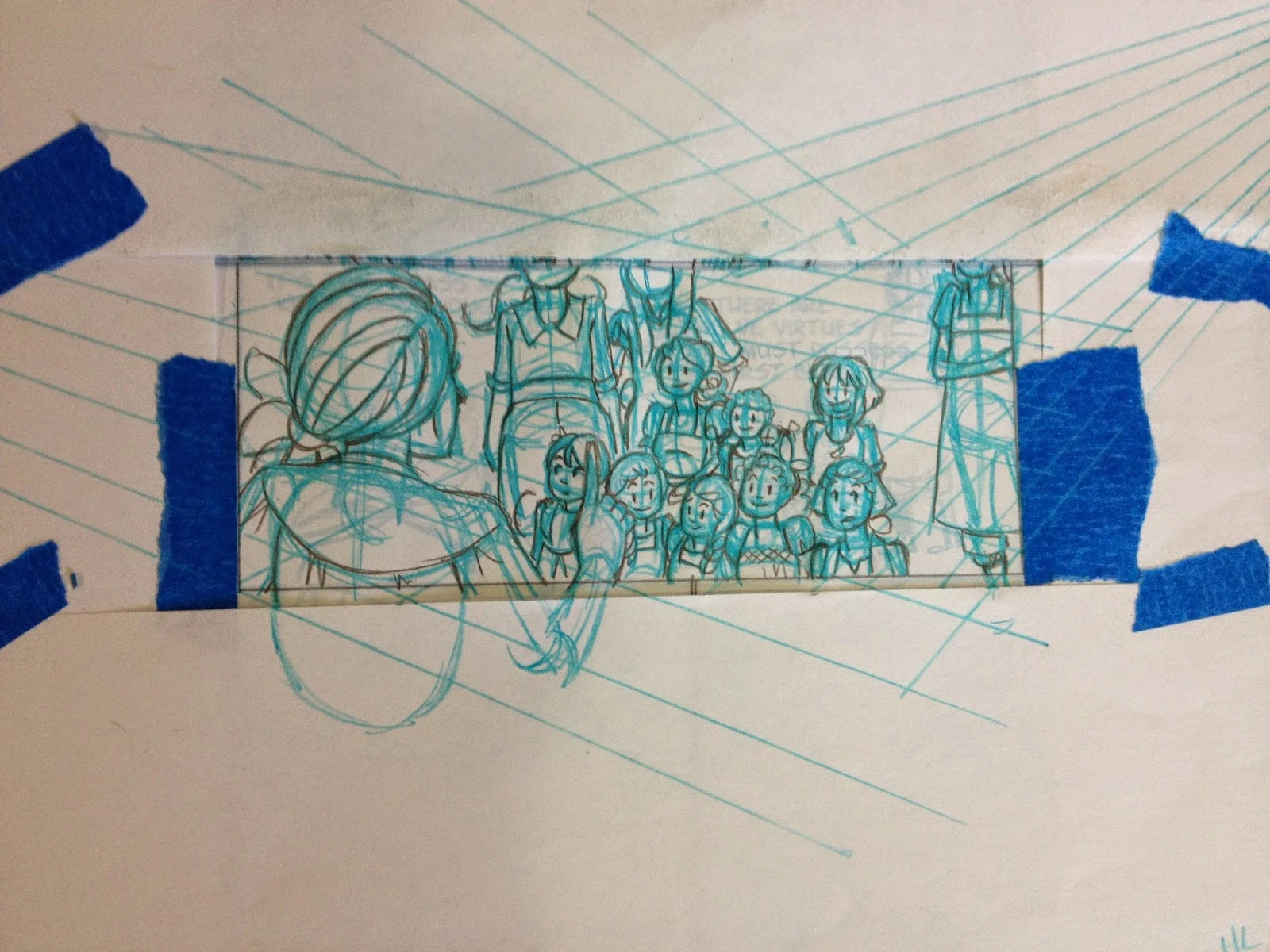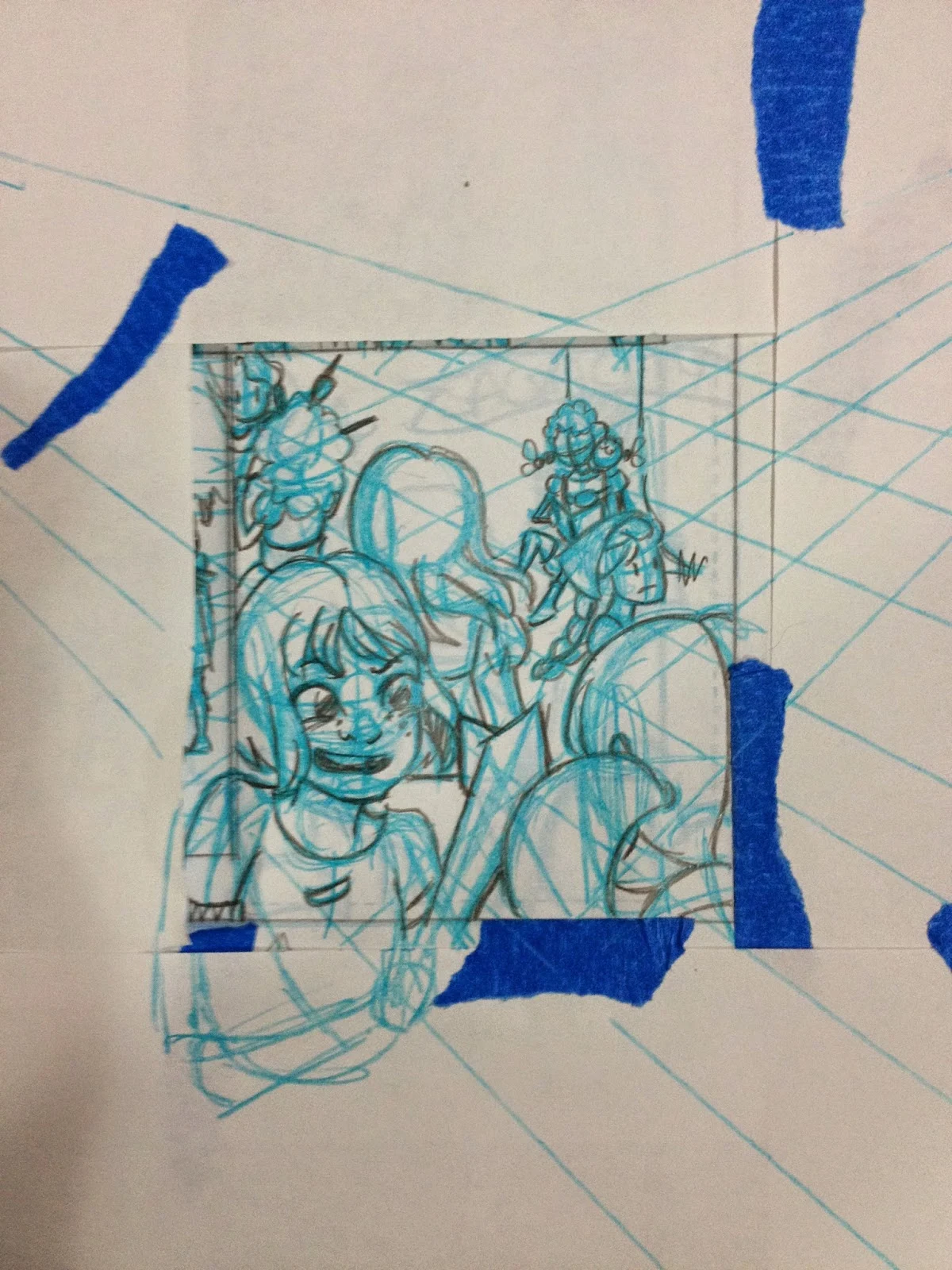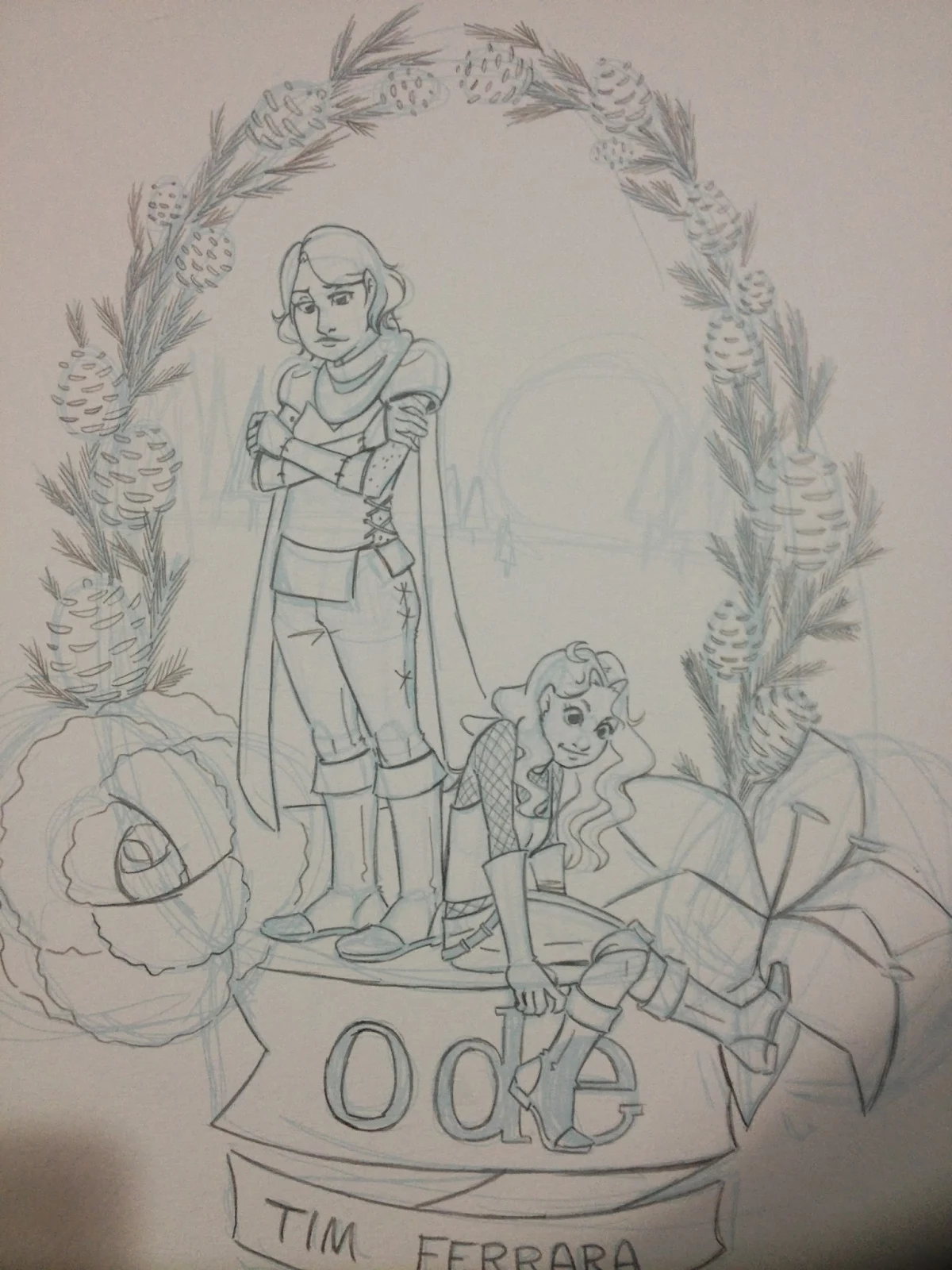All About Bluelines- Traditional Media
Recently I wrote a post reviewing Pilot's Color Eno mechanical pencil. This happened to coincide with an online friend asking me to write about my blueline process. I have two processes that involve bluelines- digital and traditional, and I'll be starting with my traditional blueline process today.
I use non photo blue lead as a presketch- capturing the gesture and larger details- and I use graphite or ink for refinement. In the past, scanners and photocopiers weren't quite sensitive enough to pick up this blue (hence why it was 'non photo'), current scanners and photocopiers are much more nuanced. These are easy enough to drop in Photoshop.
The below examples are from my March challenge, Magical Girl March, and were used in my latest mini, Magical Girl March, which debuted at TCAF and will be available in my shop. I sketched and inked directly in my sketchbook, scanned the images, and opened them in Photoshop.
With a little bit of tweaking (detailed in the tutorial linked above), I can completely drop the blue lines, bump up the white of the paper, and bump up the black ink. You'd never know I'd originally sketched with a blue pencil!
Some people use nonphoto blue markers, pens, lead holders, or traditional wooden pencils, which are fine, but I like to use mechanical pencils when I draw so I'm not constantly sharpening. There aren't many brands of nonphoto blue lead available in my favorite size of .7, but I'm pretty fond of Pilot Neox Color Eno in Soft Blue.
Con Sketches
Non photo blue lead is a must for conventions, as I crank out a lot of $5-$10 at con sketches during the show itself. Many of my customers enjoy the distinctive look of my non photo blue under drawings, although a few have requested graphite pencil and ink (graphite for easy and predictable eraseablity).
Every convention sketch starts with the same basic materials: cardstock, my blue mechanical pencil, blue lead, and a cheap clipboard.
When sketching, I start from big to small, generic to specific. I sketch out basic shapes before attempting to refine the whole, and I map out the face before drawing in details. I find that many artists get bogged down with drawing details before mapping out where the sketch is going, and when I start doing that, I have to stop myself and remember to think about where I'm going, not just how I'm getting there.
Finished Example (From my Anime Kaiju review)
I like using a softer lead for going over bluelines for con sketches. Not only does it show up darker on the paper, but it's easier on my hand, as I don't have to press as hard. I use Pilot's Neox Graphite in B, as I find it breaks less often than other brands.
Mini Watercolor Illustrations
I also use nonphoto blue pencils for my mini watercolors. Even with very simplified styles, I still utilize the same basics I use when drawing more detailed anatomy. I've written a lot about the topic over the years, so check out this search tag for more!
This sketch was used for a graphite transfer for a watercolor commission from MTAC.
For Comic Pages
Tight Roughs
I utilize my nonphoto blue pencil at almost all stags of comic creation- to sketch preliminary passes at bluelines, to layout grids for roughs, and I pencil over printed bluelines for both watercolor and inked pages.
The photos below are process shots from "Knight School", my 4 page mini comic for the upcoming 1001 Knights anthology.
Though my scanner will pick up both nonphoto blue and graphite, it's important that I drop the nonphoto blue before printing out my pages, as turning my pencils into bluelines can result in a muddy mess if I don't bump up the contrast in Photoshop.
Inks
When working on comics, I'll print out my finished tight pencils as non photo blue bluelines. From there I can continue to tighten with pencils (as shown in the below example) or go straight to inking. These pages are from the recently backed anthology, Chainmail Bikini, from my 6 page story, "Pretty Paladin Critical Missy".
For Watercolors (From the Ode Guest Art Process Post)
Even watercolors get the blueline treatment. Since deskjet printers use non-waterproof ink, I don't worry about the bluelines, because as soon as I stretch the pages, most of the non photo blue will disappear. I do try to minimize how much ink is used- I print using the fast draft setting.
After the pages are stretched though, the bluelines disappear for the most part, leaving just the pencils.
And once the watercolor is fully completed, you'd never know there had been printed bluelines below!
I use non photo blue lead as a presketch- capturing the gesture and larger details- and I use graphite or ink for refinement. In the past, scanners and photocopiers weren't quite sensitive enough to pick up this blue (hence why it was 'non photo'), current scanners and photocopiers are much more nuanced. These are easy enough to drop in Photoshop.
The below examples are from my March challenge, Magical Girl March, and were used in my latest mini, Magical Girl March, which debuted at TCAF and will be available in my shop. I sketched and inked directly in my sketchbook, scanned the images, and opened them in Photoshop.
With a little bit of tweaking (detailed in the tutorial linked above), I can completely drop the blue lines, bump up the white of the paper, and bump up the black ink. You'd never know I'd originally sketched with a blue pencil!
Some people use nonphoto blue markers, pens, lead holders, or traditional wooden pencils, which are fine, but I like to use mechanical pencils when I draw so I'm not constantly sharpening. There aren't many brands of nonphoto blue lead available in my favorite size of .7, but I'm pretty fond of Pilot Neox Color Eno in Soft Blue.
Con Sketches
Non photo blue lead is a must for conventions, as I crank out a lot of $5-$10 at con sketches during the show itself. Many of my customers enjoy the distinctive look of my non photo blue under drawings, although a few have requested graphite pencil and ink (graphite for easy and predictable eraseablity).
Every convention sketch starts with the same basic materials: cardstock, my blue mechanical pencil, blue lead, and a cheap clipboard.
When sketching, I start from big to small, generic to specific. I sketch out basic shapes before attempting to refine the whole, and I map out the face before drawing in details. I find that many artists get bogged down with drawing details before mapping out where the sketch is going, and when I start doing that, I have to stop myself and remember to think about where I'm going, not just how I'm getting there.
Depending on how pressed for time I am, I may start pencilling at this stage, or I may keep refining the sketch.
I like using a softer lead for going over bluelines for con sketches. Not only does it show up darker on the paper, but it's easier on my hand, as I don't have to press as hard. I use Pilot's Neox Graphite in B, as I find it breaks less often than other brands.
Mini Watercolor Illustrations
I also use nonphoto blue pencils for my mini watercolors. Even with very simplified styles, I still utilize the same basics I use when drawing more detailed anatomy. I've written a lot about the topic over the years, so check out this search tag for more!
This sketch was used for a graphite transfer for a watercolor commission from MTAC.
For Comic Pages
Tight Roughs
I utilize my nonphoto blue pencil at almost all stags of comic creation- to sketch preliminary passes at bluelines, to layout grids for roughs, and I pencil over printed bluelines for both watercolor and inked pages.
The photos below are process shots from "Knight School", my 4 page mini comic for the upcoming 1001 Knights anthology.
Though my scanner will pick up both nonphoto blue and graphite, it's important that I drop the nonphoto blue before printing out my pages, as turning my pencils into bluelines can result in a muddy mess if I don't bump up the contrast in Photoshop.
Inks
When working on comics, I'll print out my finished tight pencils as non photo blue bluelines. From there I can continue to tighten with pencils (as shown in the below example) or go straight to inking. These pages are from the recently backed anthology, Chainmail Bikini, from my 6 page story, "Pretty Paladin Critical Missy".
For Watercolors (From the Ode Guest Art Process Post)
Even watercolors get the blueline treatment. Since deskjet printers use non-waterproof ink, I don't worry about the bluelines, because as soon as I stretch the pages, most of the non photo blue will disappear. I do try to minimize how much ink is used- I print using the fast draft setting.
After the pages are stretched though, the bluelines disappear for the most part, leaving just the pencils.
And once the watercolor is fully completed, you'd never know there had been printed bluelines below!
I think that just about covers how I use bluelines in traditional media! Different artists have preferences of their own, so if you see someone with an interesting technique or process, you should ask them about it.







.JPG)














Comments
Post a Comment